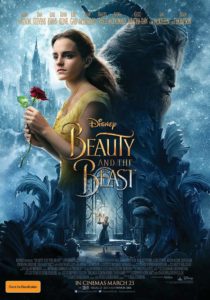Disney’s Gay Moment in Beauty and the Beast

Beauty and the Beast is the classic tale of the beautiful townswoman Belle, who falls unexpectedly in love with her captor, the cursed beast who lives in a remote enchanted castle in the woods outside her town. The timeless story popularized by Disney in the early 1990s is now a thrilling live-action film directed by Bill Condon. I had the pleasure of seeing this visually stunning movie last Friday on opening night.
I’m normally not one who clamors to see a film the first day, or even the first week it comes out, so I thought my plan to catch an 11 p.m. screening would ensure a quiet viewing. I quickly realized my naiveté, as I was surrounded by nearly 200 ten-year-olds with enough energy to power a small city.
Though Beauty and the Beast was always one of my favorite Disney movies, and I was admittedly excited to see the live-action remake for personal reasons, I was on a mission to better understand the whole “gay moment” controversy that has been looming over the film for months. The new version had already been banned in various places for “blasphemous” content. Malaysian officials asked Disney to remove the questionable scene, but when Disney refused, they threatened to cancel the film’s release. It was eventually released under a PG-13 rating. Owners of an Alabama drive-in banned the film, telling the New York Times that they would “not compromise on what the Bible teaches.”
I was sure this moment, a display of love between two people of the same sex, in a live-action version of a beloved Disney classic, would turn a few heads in the theater. But my head never turned. As each scene passed, I patiently waited for the “moment” everyone’s been talking about. The first hour passed, the second hour passed, and then the film was over. I left the theater feeling confused and a little annoyed. I couldn’t for the life of me figure out what conservative Christians were so upset about.
I wasn’t the only one who felt this way. Most people I’ve talked to and the reviews I’ve read all had the same problem locating this supposed scandalous gay moment.
Director Bill Condon said that he intentionally made the character LeFou (Josh Gad) gay, and there are a few subtle suggestions that he has a crush on Gaston (Luke Evans). The “moment,” however, has LeFou dancing with another man in the ballroom scene at the end of the movie while everyone is switching partners in the middle of the dance. It was so quick, so innocent, you really had to look for it and question his every move to maybe know what they were talking about. As far as I could tell, no one in the theater seemed offended and all of the kids clearly loved the movie.
The level of intolerance it takes to ban this film for a two-second moment—that takes place in the last two minutes and is so mildly intimate that you really have to stretch to call it a same-sex love scene—is mind-boggling. Clearly the message from the morality police here is strongly anti-LGBT. Where was the opposition to drug use in Alice in Wonderland or the use of witchcraft in The Little Mermaid? How about bestiality, misogyny, murder, ageism, and abuse in Beauty and the Beast itself? No, what we’re seeing here is a clear response to a hot-button issue that conservative religious groups feel poses a threat to their way of life. In fact, I would have loved the two-second moment to have been longer and more deeply explored—to show viewers that both the real world, and the world of Disney, is becoming a world of acceptance and recognition of equality.
The new Beauty and the Beast is visually stunning, the acting is decent, and it stays true to the original storyline. Belle (Emma Watson) is even more of a feminist in this version, which is great to see. Come to think of it, this might also really bother conservatives—if they could stop talking about the two-second gay scene long enough to notice.
